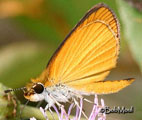Native Plants
Search for native plants by scientific name, common name or family. If you are not sure what you are looking for, try the Combination Search or our Recommended Species lists.
Phalaris arundinacea
Phalaris arundinacea L.
Reed Canary Grass
Poaceae (Grass Family)
Synonym(s): Phalaris arundinacea var. picta, Phalaroides arundinacea, Phalaroides arundinacea var. picta
USDA Symbol: phar3
USDA Native Status: L48 (N), AK (I), CAN (N), SPM (I)
Grows in large patches, the flowering stalks jutting in a uniform layer over the leaves, which also grow to a uniform height. The flower stalks do not persist long after flowering.
This grass is much planted for hay but is also naturally established. Like many marsh plants, Reed Canary Grass spreads by rhizomes and soon forms large patches. The inflorescences can be mistaken for those of Orchard Grass (Dactylis glomerata), but they are more fragile and smooth-textured, and the growth habit is different: Orchard Grass grows in distinct clumps on drier soil. A cultivated variety of Reed Canary Grass, Phalaris arundinacea 'Picta' with white stripes on the leaves, is known as Ribbon Grass and is often planted in gardens.
Plant Characteristics
Duration: PerennialHabit: Grass/Grass-like
Root Type: Fibrous
Leaf Arrangement: Alternate
Leaf Complexity: Simple
Leaf Venation: Parallel
Fruit Type: Caryopsis
Size Notes: Up to about 7 feet tall.
Leaf: Green
Bloom Information
Bloom Color: YellowBloom Time: Apr , May
Distribution
USA: AK , AL , AR , AZ , CA , CO , CT , DC , DE , IA , ID , IL , IN , KS , KY , MA , MD , ME , MI , MN , MO , MT , NC , ND , NE , NH , NJ , NM , NV , NY , OH , OK , OR , PA , RI , SD , TN , UT , VA , VT , WA , WI , WV , WYCanada: AB , BC , MB , NB , NL , NS , ON , QC , SK
Native Distribution: Maine to Virginia, west to Washington and California.
Native Habitat: Low, wet places, riverbanks, marshes.
Growing Conditions
Water Use: HighLight Requirement: Sun
CaCO3 Tolerance: Medium
Benefit
Warning: Some Phacelia species produce a skin irritation in sensitive people, similar to that of poison oak or poison ivy.Attracts: Butterflies
Larval Host: Least Skipper (Ancyloxypha numitor)
Butterflies and Moths of North America (BAMONA)
|
Least Skipper (Ancyloxypha numitor)  Larval Host |
National Wetland Indicator Status
| Region: | AGCP | AK | AW | CB | EMP | GP | HI | MW | NCNE | WMVE |
| Status: | OBL | OBL | FACW | FACW | FACW | FACW | FACW | FACW |
Bibliography
Bibref 1186 - Field Guide to Moths of Eastern North America (2005) Covell, C.V., Jr.Bibref 1185 - Field Guide to Western Butterflies (Peterson Field Guides) (1999) Opler, P.A. and A.B. Wright
Search More Titles in Bibliography
Additional resources
USDA: Find Phalaris arundinacea in USDA PlantsFNA: Find Phalaris arundinacea in the Flora of North America (if available)
Google: Search Google for Phalaris arundinacea
Metadata
Record Modified: 2016-02-01Research By: TWC Staff